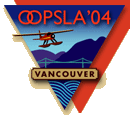
| Program |
 |
|
|
|
| Find in Program |
 |
|
|
|
| Page |
 |
|
|
|
| Basket |
 |
|
view, help
"Bots & Pieces: A Hands-On Investigation of Generative Pattern Languages using Mindstorm Robots"
|
|
|

|
Bots & Pieces: A Hands-On Investigation of Generative Pattern Languages using Mindstorm Robots
Metropolis
Sunday, 8:30, full day | 7 | · | 8 | · | 9 | · | 10 | · | 11 | · | 12 | · | 13 | · | 14 | · | 15 | · | 16 | · | 17 | · | 18 | · | 19 | · | 20 | · | 21 |
Alan O'Callaghan, De Montfort University: A researcher, lecturer and practising consultant in Object Technology, Software Architecture and software patterns for more than fifteen years, Alan is the author of 3 books and more than 40 papers in these areas. He is a member of the Hillside (Europe) advisory board and the EuroPLoP planning committee. He has authored the ADAPTOR pattern language for object and component-based re-engineering and heads the JANUS Centre—a resource for software architects in the UK—at De Montfort University. He is a popular presenter at conferences such as rOOts, vikingPLoP, EuroPLoP and has previously contributed OOPSLA tutorials on 3 occasions. He is co-author of the Bots & Pieces pattern language which is the subject of this tutorial.
Maria Kavanagh, De Montfort University: Maria Kavanagh is a Senior Lecturer at De Montfort University and a leading member of its Janus Centre. She is currently researching patterns for business modelling, and besides being co-author of the "Bots and Pieces" pattern language, is writing a pattern language for business processes. She has authored many papers on software development. She is a member of Hillside (Europe), the facilitating organization of the patterns movement.
Tutorial number: 19
Pattern languages have been a hot topic since design
patterns were first introduced into software. But is a
truly "generative" pattern language possible? Nothing
in the lexicon of software patterns comes close to
Alexander's concept which follows a theory of natural
order based on centres and pattern sequences which are
generic rules for making centres for 3D systems. The
Bots and Pieces pattern language is a candidate
pattern language of this type in which integrated
solutions are created by an agile process consisting
essentially of the application of patterns one after
the other—without any other kind of "Process"
being involved.
The feasibility of generative pattern languages for
software systems is explored by teams creating Lego
Mindstorms robots to win a competitive 'race'. More
than half the tutorial time is used in creating and
programming the robots (in either Java or NQC)from
scratch. The Bots & Pieces pattern language is
provided as a resource to the teams. After the winner
of the competition—running the robot around a track
in the quickest time—is determined participants will
collectively reflect and evaluate their experience and
prepare a report back (via posters) to the rest of
OOPSLA.
Beginner: No previous experience of Mindstorm robots or patterns
is required. Some programming knowledge is useful.
|
